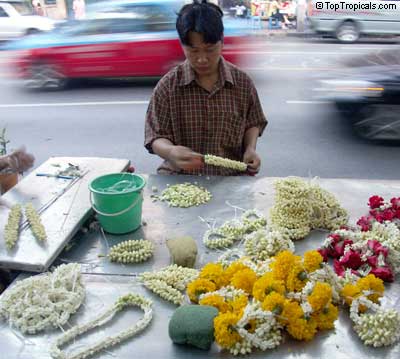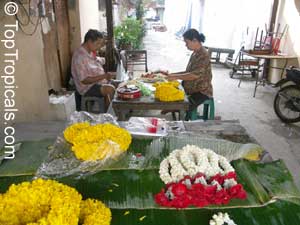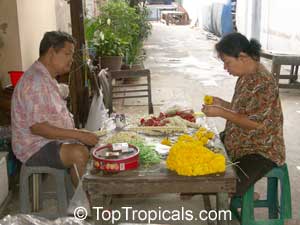Jasminum Sambac - History and Facts (by Mike) ||
 | Some botanists now agree that the plant originated from India -- from the northern parts of the Himalayan valleys, although it is grown throughout India today. Others place the origins of the sampaguita even farther off to Egypt and Persia or present-day Iran.
Since ancient times Jasmine has been thought of as the 'queen of flowers'. The name Jasmine is derived from the Persia 'yasmin', meaning a fragrant flower. It's also a Persian girl name.
Plant must have been introduced into Egypt prior to the time of the XXI dynasty (around 1000 BC).
It was said that a Chinese emperor of the Sung dynasty (960-1279 AD) had Jasmine in his palace grounds so he could enjoy its fragrance. In the 1400s, Jasmine was planted for kings of Afghanistan, Nepal and Persia.
Varieties of Jasmine used in perfume, found their way to places across the seas -- beginning from areas along the Arabian Sea, such as Persia and India then crossing the Red Sea into Egypt. They reached into the territory around the Aegean Sea into Turkey and Greece. And, they spread to areas along the Mediterranean Sea from Africa through Egypt, Algeria and Morocco -- reaching Western Europe through Spain by Moors in 1600, and France and Italy.
The plant was introduced into Britain in the latter part of the 17th century.
|
Jasmine sambac ("Maid of Orleand" single variety), sampaguita, is the national flower of Phillipines. It is a symbol of purity, simplicity, humility and strangth.
Referring to famous Swedish botanist Linnaeus, he wrote that the natives of India used the young leaves and flowers to make a putty, which was mixed and eaten with rice to dry scabies and other skin eruptions.
| 
 | In India some varieties are used as religious offerings symbolizing divine hope. The Hindus string the flowers together as neck garlands for honoured guests. The flowers of one of the double varieties ("Belle of India") are held sacred to Vishnu and are used as votive offerings in Hindu religious ceremonies.
Pictures: Left - many Indian women wear garlands of Jasmine flowers in their hair. This woman was stringing some garlands in a market.
Below: Jasmine sambac ornament
|
 | The variety Jasminium sambac, is a clustered flower of equally strong scent known in Hawai'i as the "Pikake". It was a favorite of Princess Kaiulani who was also very fond of Peacocks, thus the name of the flower pronounced as pea-cock-kay".
Jasmine sambac is one of Indonesia national flowers. It is used in Indonesia as a popular garnish. The existence of the Jasmine flower is described comprehensively in the script called Siwaratrikalpa (old Javanese literature) composed around XV AD when Adi Suprabawa governed the Majapahit kingdom, East Java. This flower was called "menur" in this script. It also stated that Jasmine has already existed in Indonesia since XV AD and this is a good flower to worship Ciwa in the new moon of the seventh month or the month of Magha. This is the holy night to worship Ciwa to wipe out one's sin. Magha comes once a year or every 420 days according to the Balinese calendar. The Ciwa worshippers use Jasmine flowers in their offerings. It is believed that this flower brings forgiveness and blessing and eventually they will be able to be united with Ciwa in heaven. |
The Jasmine flower is called by different names in Indonesia or Bali - menur, melur, menuh, melati and melate. In Javanese weddings, this flower is commonly used for hair and dagger decorations for the bride and the groom. On the contrary it is not used in Balinese weddings. In Bali other flowers are used for the wedding such as the yellow and white Champak flower including Kenanga. The Jasmine flower can also be used to cure fevers as well as to flavor tea or to make perfume. In Bali people plant this in themain temples or the family temples. Jasmine is a good flower to use as a medium of praying to worship the god Iswara. The color of this god is white and located in the east. This flower is also used for the big ceremonies such as Tawur Agung - the ceremony to bless the whole world.
In Borneo it is the custom among the women to roll up Jasmine blossoms in their well-oiled hair at night. |  |
No comments:
Post a Comment